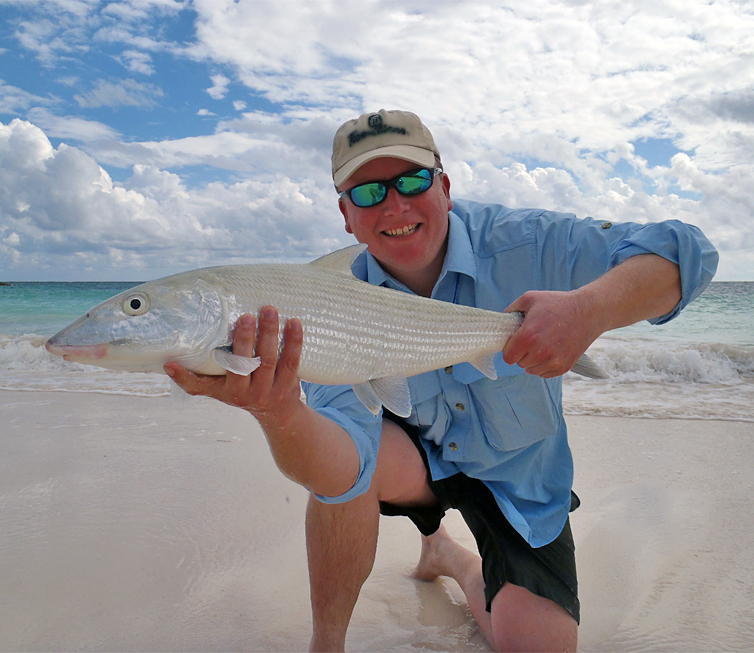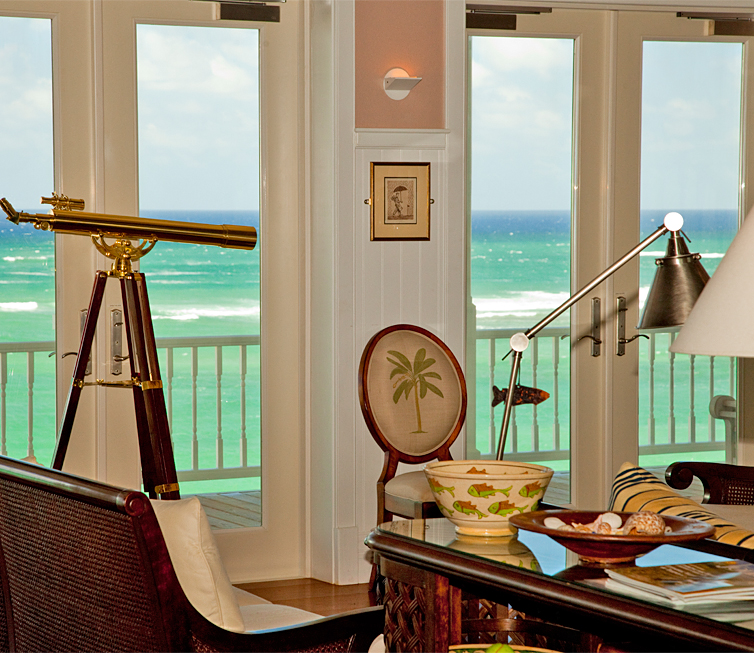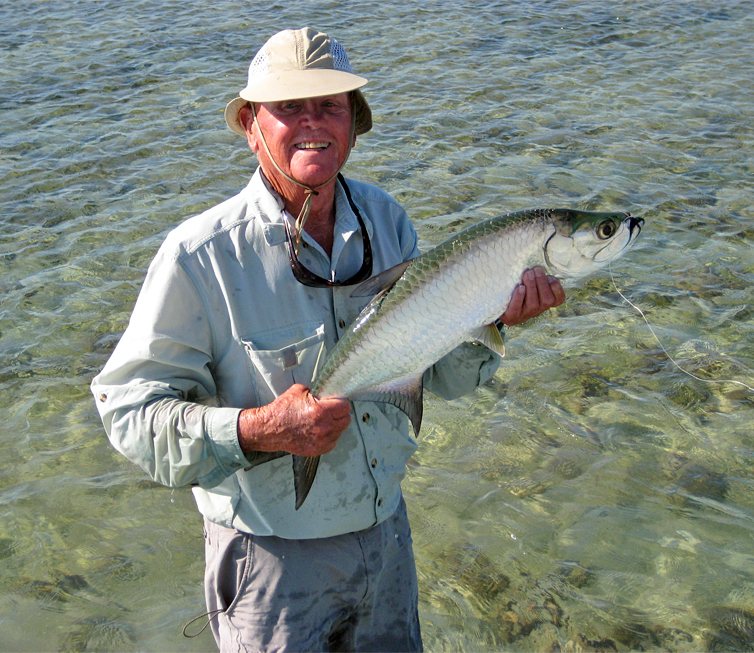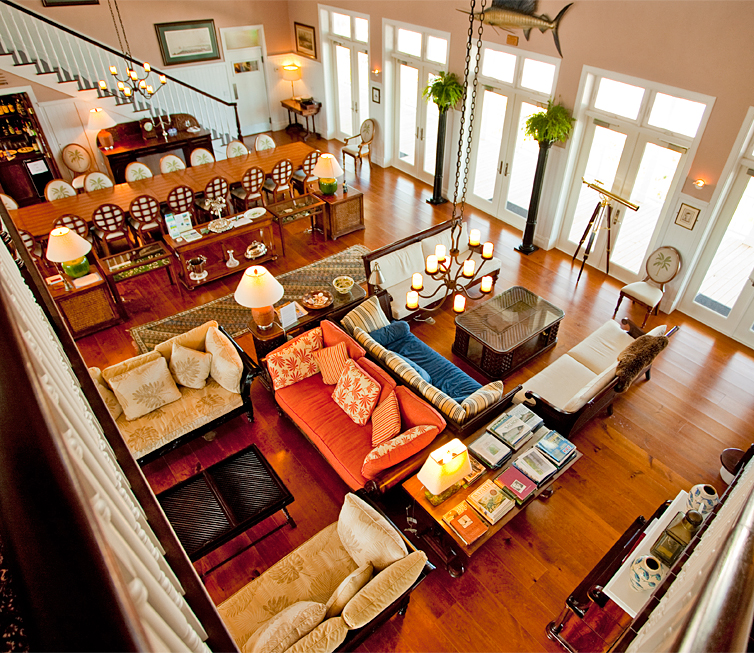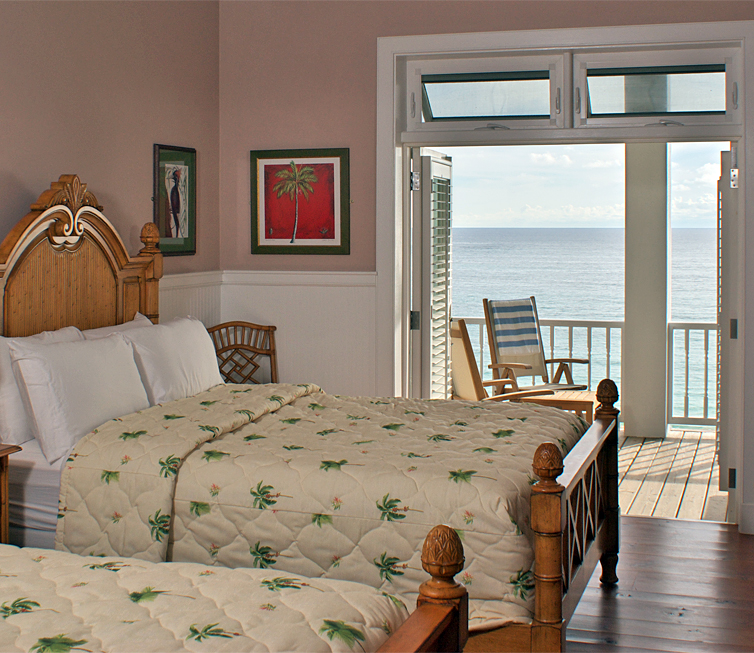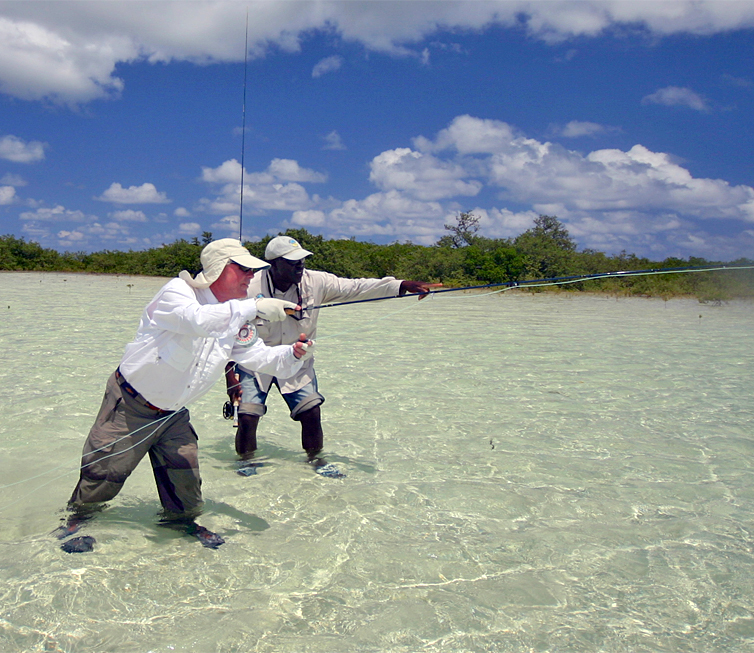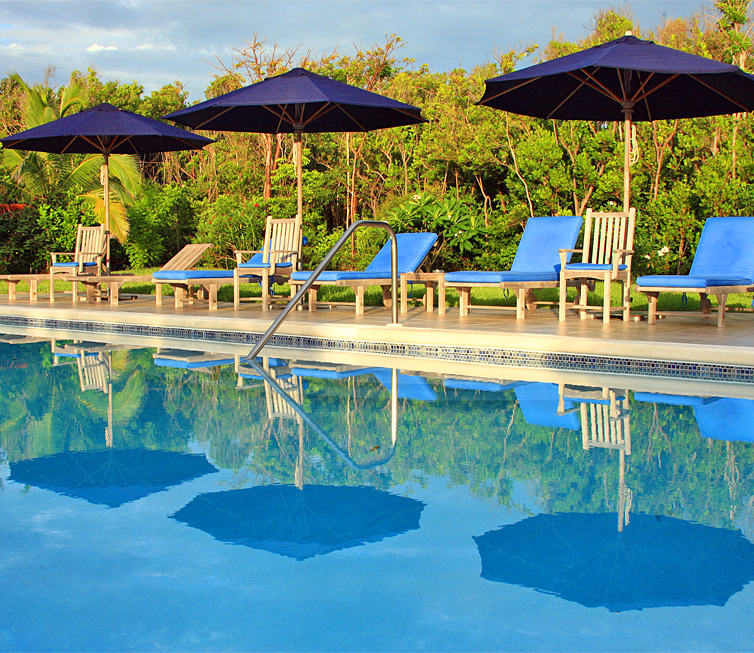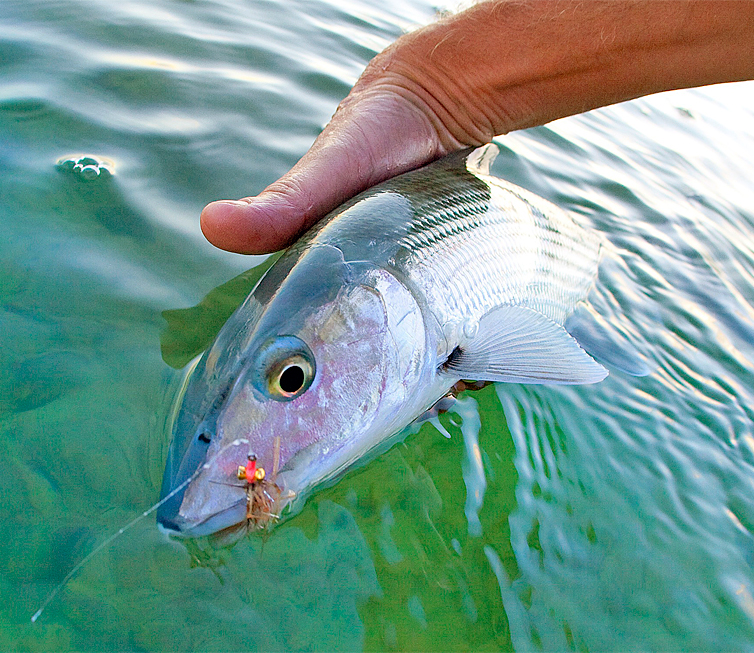The fabled Marls on the west side of Abaco offer more than 200 square miles of backcountry bonefishing flats, just minutes from the lodge. This is a massive complex of islands, channels and flats that are home to more bonefish than you can imagine. South of the Marls is Sandy Point, providing angling access to the southern end of Abaco, including Gorda Cay, Moore’s Island, and Cross Harbour. This is bonefish country, with shots at permit and tarpon as well.
With a private staircase leading down to a secluded white sand beach, the Delphi Club rests on a tree lined ridge overlooking coral reefs and the Atlantic Ocean. Lush green vegetation was carefully opened for the lodge, pool and garden sites. Upstairs, the lodge boasts two king suites with private ocean view decks, and downstairs, with private access from a spacious covered porch, are four double and two more king suites. All guest rooms are distinctly appointed with elegant furnishings , large stone and glass showers, and beautiful artwork.
If you’re looking for a stunning beachfront location offering diverse and productive bonefish waters, this is the place! The lodge, staff, food, guides and fishing are all first class.
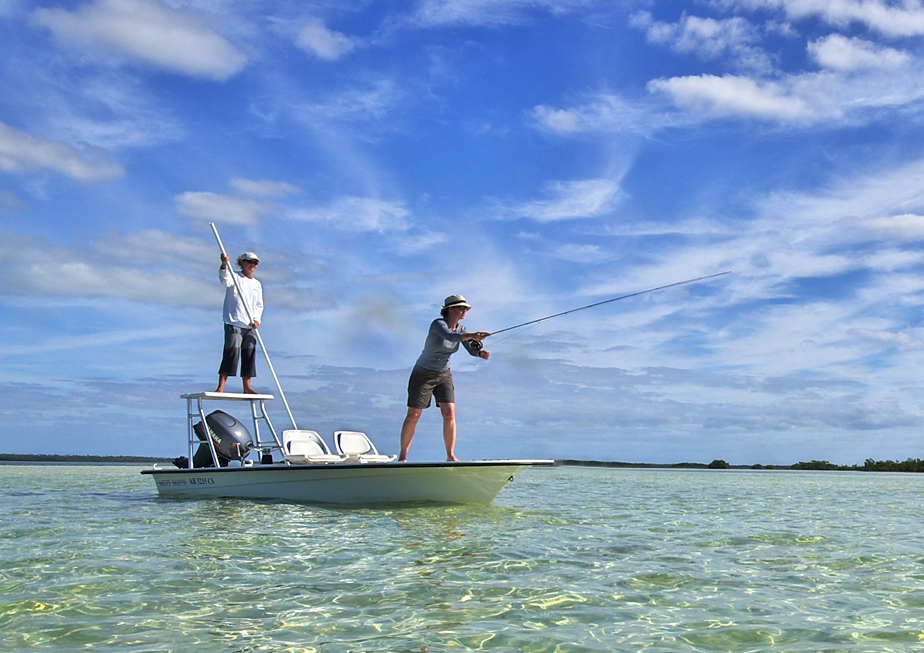
Reservations & Rates
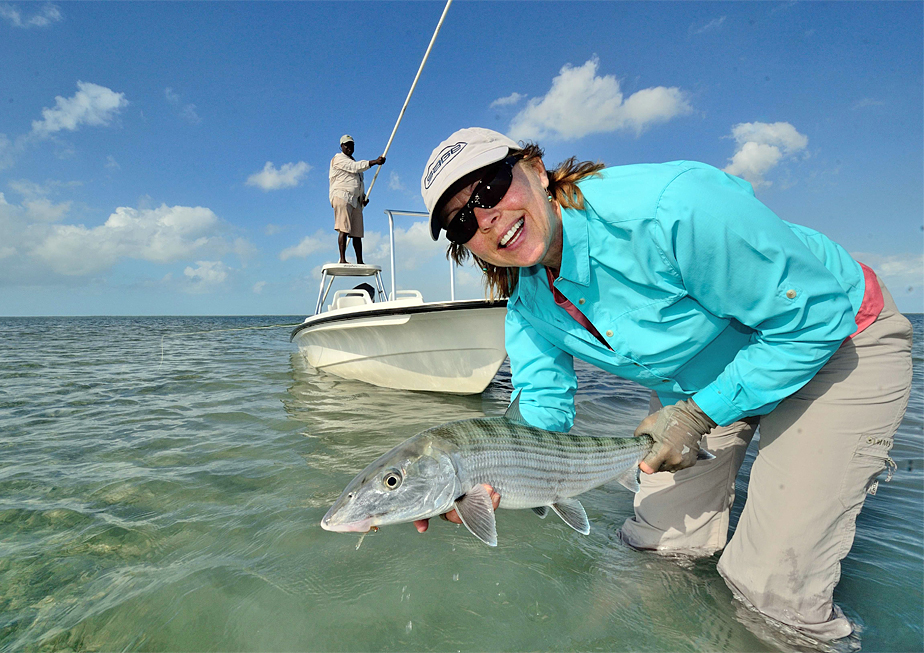
Seasons at The Delphi Club
The Delphi Club has scheduled its season according to best fishing; October through June.
This avoids the summer doldrums that can affect the flats with water that warms during the late morning and afternoon, pushing the bonefish into deeper, cooler water. It also avoids the height of the hurricane season, July through September.
Read More
October through the mid-winter lures the big ocean bones out of the deeper water and onto the flats. This is the time to expect some of the biggest bonefish of the season. They are tolerant of cool water temperatures, and often feed aggressively in very shallow water.
Mid-winter through early spring is a great time to fly south and get a break from winter. Weather plays an important part of any saltwater fly fishing trip, and with decent to good weather the fishing will be outstanding on the flats. Occasional cold fronts will blow through, but they rarely last very long, and the water on flats will warm up as fast as they cooled. Fish returning back to the flats after a cold front are there to feed, and present very exciting fishing.
Spring through June is probably the safest time to fish the flats of the Bahamas. This time frame is beyond most, if not all of the cold fronts that will affect the fishing, and before the heat of summer. Best of all, the fish are happy and feeding regularly.
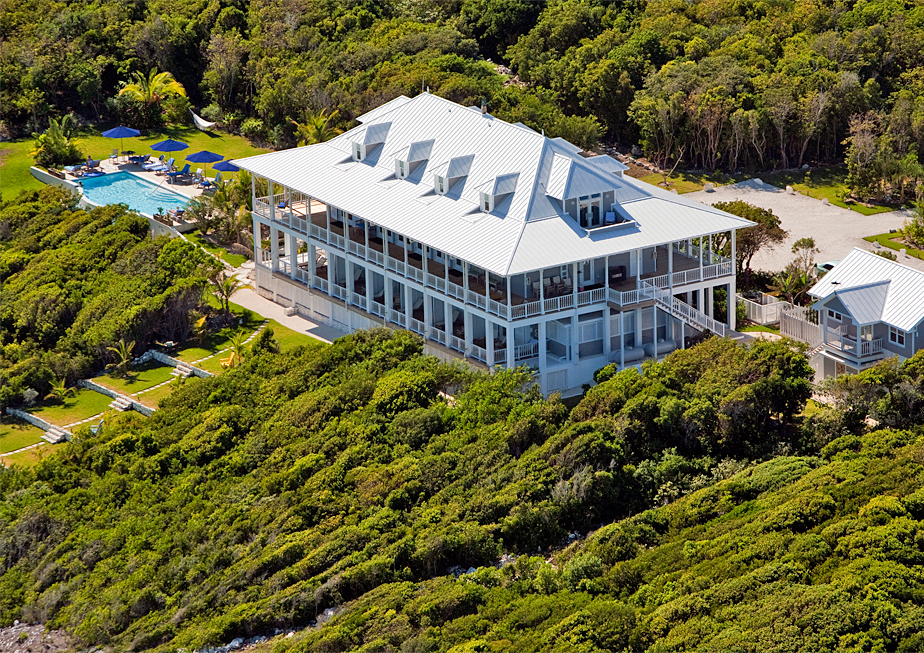
Getting to The Delphi Club
There are direct commercial flights to Marsh Harbour from Miami, Ft. Lauderdale, West Palm Beach, Orlando and Atlanta, making your travel to Abaco quick and convenient. Private aircraft can also land at Marsh Harbour direct from the US, as the airport has an international port of entry and customs clearance facilities.
Transfers from the Marsh Harbour airport to the Delphi Club are normally by taxi, included in the package price. Once your bags are loaded into the
Read More
air conditioned transport, you will be driven to the lodge, about 30 minutes south. The Club staff will greet you upon arrival, and show you to your room, where you will find your luggage. There is no organized fishing on your arrival day, but you can wade fish in front of the lodge, walk the beach, or relax in the pool with a cooling drink.
On your day of departure, you will be driven back to Marsh Harbour with plenty of time to meet your flight. The Delphi Club manager will assist you with timing your transfer from the lodge the evening prior to departure.
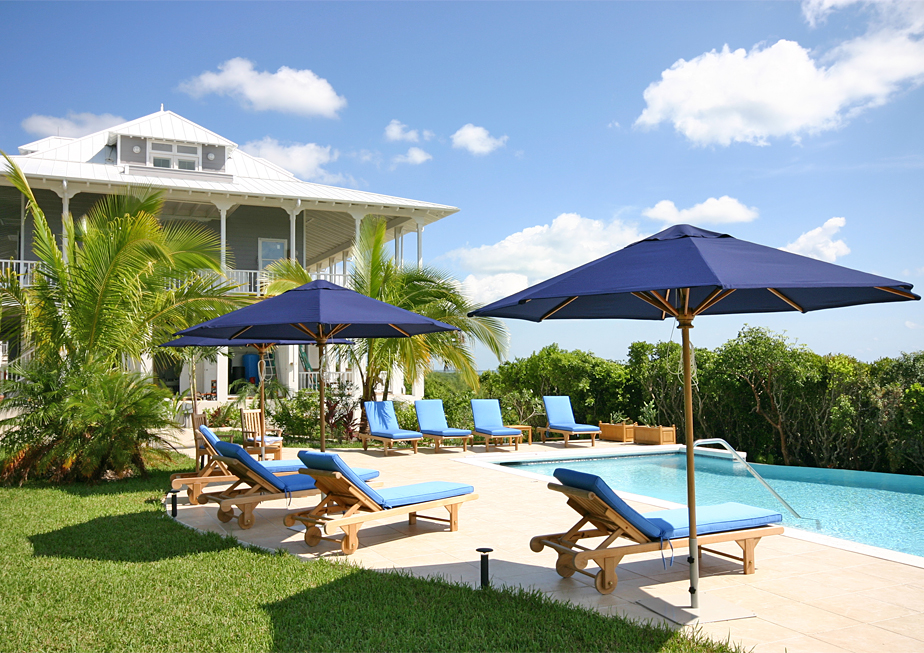
Lodging at The Delphi Club
The Great Room at the center of the lodge features an enormous dining table, well stocked bar, abundant comfortable seating and stunning views of the beach, coral reefs and the Atlantic Ocean. With fine antiques and an overhead gallery stocked with fishing paraphernalia, the Great Room is full of character and atmosphere. The adjacent library holds a wide choice of books, and houses the lodge television.
Six of the Club’s eight bedrooms are on the ground floor. and two more are on the third floor. Each has lovely ocean views, and there is a choice
Read More
of super-kingsize beds or queen size twins. The rooms are well appointed with fine furniture, stone and glass showers, and private refrigerator.
Outside, the landscaped gardens feature bougainvillea, frangipani, oleander, hibiscus, fichus and a wide variety of palms and shrubs. There’s an attractive infinity pool and patio with comfortable sun loungers , perfect for a refreshing swim after a day on the flats.
Due to its highly secluded location (it can only be accessed by a mile-long forest laneway and there is only one other house within a one mile radius), the Club is an ideal hideaway for those wishing to escape the glare of public life. The small staff is reliable and discreet.
The Delphi Club’s food holds its own the best in the Bahamas. The head chef has worked in several top restaurants in Europe and the Caribbean, and the author of several regional cookbooks. He selectively sources his food ,making optimal use of local ingredients and fresh local seafood, all served in an elegant setting overlooking the ocean.
The Club is run in the style of a country house party, where the characters change from time to time. There are no bell hops or room service – it’s just a relaxed gathering of kindred spirits in a spectacular location with the best of everything.
Schedule:
6:30 AM: Coffee ready on the buffet table
7:15 AM: Breakfast
8:00 AM: Depart for fishing
4:30 PM: Return to lodge
4:30 TO 5:30 PM: Cocktail hour
6:15 PM: Appetizers
7:00 PM: Dinner
Food and Drink:
The breakfast buffet includes Jamaican Blue Mountain coffee served in individual french presses, fresh fruit, yogurt, delicious breads, with eggs and meat to order. A lunch made to your order will be waiting in a cooler on your skiff, along with plenty of iced bottled water and selected beverages. The garden side pool is the perfect place enjoy a cold beverage and take a leisurely swim after fishing. Cocktails and appetizers are ready shortly after six, and the expansive covered porch is the ideal location to enjoy the afternoon breeze and savor the moment with your friends. Guests share dinner together at one long table. It’s a bit like a big dinner party. The food is excellent. The menu is set, although there is always the choice of a meat dish or a fresh fish dish for the main course.The Delphi Club has a selection of wines to order, along with Bahamian beer and mixers. The night’s stars are exceptionally bright, and a moonrise over the ocean is a soothing way to complete your day.
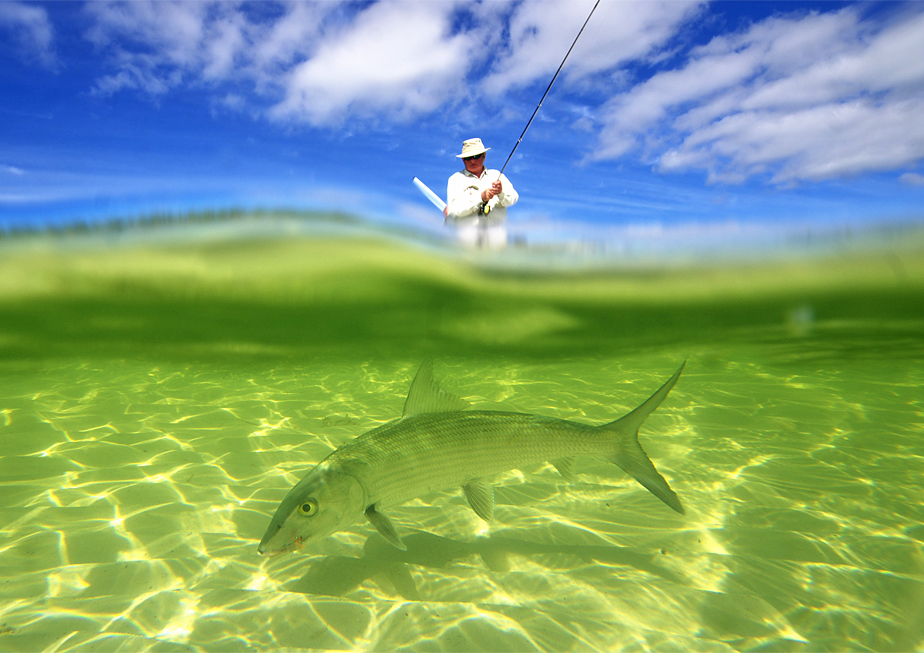
Fishing at The Delphi Club
The islands throughout the Bahamas are bonefish heaven, and Abaco is no different.The bonefish in the Marls average 2-4 pounds with the occasional larger fish. The ocean side flats offer opportunities at some of the biggest bonefish in the Bahamas, with big fish pushing the ten pound mark. There are the occasional shots at permit, tarpon, 'cudas, jacks, and sharks, and it is recommended that you bring the appropriate tackle just in case. There is nothing more frustrating than seeing a 20 lb permit tailing, or a 5 ft. tarpon cruising the flat, and not having the right gear set up.
Read More
The majority of the fishing in the Marls is done from the skiff, as the bottom is typically soft, making wading difficult. Wade fishing opportunities are available if you prefer, and your guide can usually take you to wadeable flats depending on the tide. Runs from the boat launch to the flats vary from 10 to 45 minutes. The Club fishes 16ft Dolphin skiffs with 40hp Yamaha motors. Each skiff has padded seats, a leaning bar on the casting deck, dry storage lockers, radios & GPS locators. The guides and the launch points for the boats are rotated during the week to provide maximum diversity in fisheries and opportunity. Boat launch points are normally just a 10-20 minute drive from the Club, although a few launches require a bit more driving time.The guides are all highly competent, experienced professionals.
In addition to the wonderful flats fishing, Abaco has world class blue water fishing. We are happy to coordinate a day or two with the best captains available in search of marlin, sailfish, dorado, wahoo, or tuna depending on the season. Arrangements can be made at the lodge, but the best captains book early and we recommend you do as well. There will be an additional charge for this fishing.
Fishing Techniques:
One of the biggest mistakes a bone fisherman can make is not to adjust his fly to changing water depth. Your fly should be weighted such that it sinks quickly to the bottom and then stays near the bottom within view of the fish after you begin stripping. However fishing too heavy a fly in shallow water will undoubtedly spook many fish. Often bonefish are spooked by seeing flies that do not match the environment in which they are swimming. A fly that matches the background color of the flat you are fishing, can pay dividends. Please consult your guide in making fly choices, as he brings years of experience for your benefit.
Typical Depth:
The average flat depth, whether you're wading or poling, ranges from 12"-30". In this depth, a Gotcha or Shrimp pattern with medium sized bead chain eyes should provide close to the perfect sink rate without overweighing the fly . A good rule of thumb is your fly should reach the bottom in about 3 seconds. If you find your fly is not getting to the bottom, you should switch to a fly with lead eyes or add a few wraps of lead wire to the eye of the fly.
Deeper Flats:
The angler who is willing to fish deeper flats will often be rewarded with the largest bonefish. Big bonefish prefer the protection of deeper flats or shallow flats close to deep water. When you're fishing water 3-4 feet deep, you'll need a fly with lead eyes to get to the bottom quickly. A proven deep water fly is the Clouser minnow, and the two best color combinations for bonefish are tan and white and chartreuse and white. Another effective, deep water fly is the Simram, which is a fuzzy (rabbit fur) version of the Gotcha fly with lead eyes.
Shallow Flats & Tailing Fish:
The last thing a bone-fisherman wants to do is scare an actively feeding fish in super shallow water. Therefore, you must go light to your lightest flies in skinny water. By light we mean no weight other than the weight of the hook. For this we recommend mono or plastic eyes and a body that lands softly. Good fly colors include combinations of tan, brown, white and pink.
A Day at the Delphi Club:
Your fresh morning coffee is waiting at six thirty, overlooking sunrise across the Atlantic Ocean. A complete buffet and breakfast to order begins at seven fifteen. Your guide will be waiting with your skiff on the trailer, ready to depart at eight for your chosen destination for the day. Lunch will be in your iced cooler, along with plenty of water and beverages. You’ll fish until just before four in the afternoon, returning to the Delphi Club around four thirty. The garden side pool is the perfect place to cool down and enjoy a swim after fishing. You’ll talk with the fishing manager and decide on your angling destination for the coming day, and select your lunch from the menu.Cocktails and appetizers will be ready at six fifteen. Your dinner will always be your choice of a meat or seafood entree, served between seven and seven thirty. The Delphi Club has a selection of wines to order, along with Bahamian beer and mixers. The night’s stars are exceptionally bright, and a moonrise over the ocean is soothing way to end your day.
Weather:
Cooled by the prevailing south-easterly trade winds in the summer and warmed by the surrounding waters and the Gulf Stream in the cooler months, the Abacos are rarely uncomfortably hot or cold…..Although the central Abacos are on the same latitude as Palm Beach, Florida, the winter temperatures average 10° (F) warmer than Florida and the summer highs are generally somewhat lower than those found on similar Florida latitudes due to the moderating effects of the surrounding waters. The average daily highs and lows rarely differ by more than 12 degrees (F), with monthly rainfall averaging about 2 inches in the winter and 6 inches in the summer, primarily in the ‘20-minutes-and-they’re-gone’ afternoon showers.
Non-Angler activities:
Abaco has a very good tourism infrastructure and offers a wealth of attractive options for day trips, many of them involving boat rides. The outer cays, with their charming colonial settlements such as Hope Town and Green Turtle Cay are easily reached by ferries from Marsh Harbour and Treasure Cay, and make for pleasant day trips. Golf is available at Treasure Cay and sometimes, by special arrangement, at the superb Winding Bay course. The Club has close links with excellent scuba diving instructors and snorkeling guides.
What Makes This Destination Special and Unique?
• Abaco Island is easily and quickly reached from the States with daily direct flights to and from Marsh Harbour from Miami, Fort Lauderdale, West Palm Beach, Orlando and Atlanta. Expedited international travel makes the Delphi Club a perfect weekend get-away, especially for those anglers that reside on the Eastern Seaboard. Less travel translates into more time on the flats hunting bonefish.
• The Delphi Club is one of the nicest and most deluxe bonefishing lodges in the world and a very suitable destination for non-anglers with variety of activities that will keep companions active and happy, including a freshwater pool and great ocean-side beach for walks. The lodge is a thirty minute drive from Marsh Harbour where non-fishing companions can choose from a myriad of activities; diving, shopping, ferry rides to out island cays, cultural interpretation sites – the lodge provides daily shuttle service to and from, part of the package. While you are out catching bonefish, your companion will be well looked after and happy on your return.
• The Club offers world-class luxury accommodations and lodge grounds that will satisfy the most demanding guest. The food is gourmet, prepared by a trained staff and the attention to detail is spot-on. This is a destination where all your wants and needs will be met and exceeded. All you need to do is relax, be waited on hand and foot and enjoy your worry free angling holiday.
• The Fishing program at The Delphi Club is geared toward serious anglers looking for a more solitude fishing experience. That means the fish are less pressured, happy fish, fish that like to eat. In addition being able to access both the east and west side of the island is a huge advantage when it comes to selecting the fishing location for the day. No matter what the wind and weather, the guides at the Club know where to find the fish and where conditions are most suitable; anglers seldom lose a day of fishing. Now that’s peace of mind!

